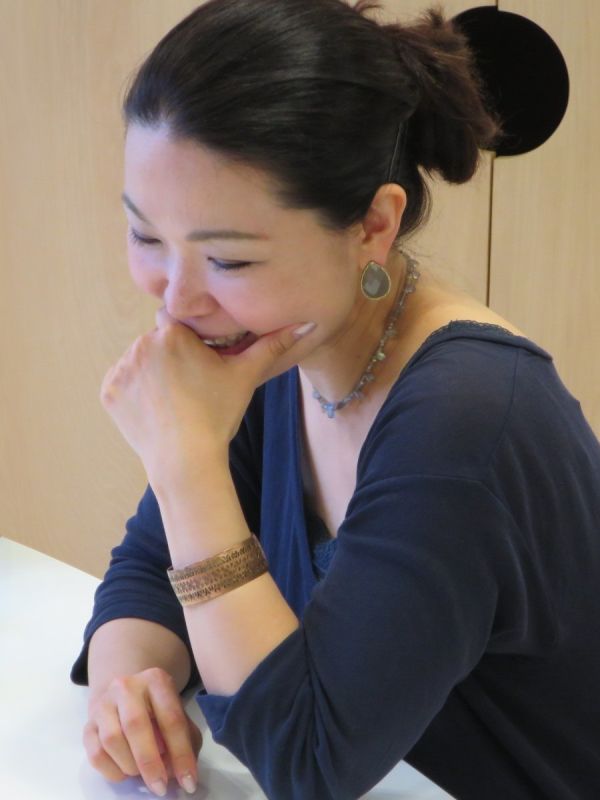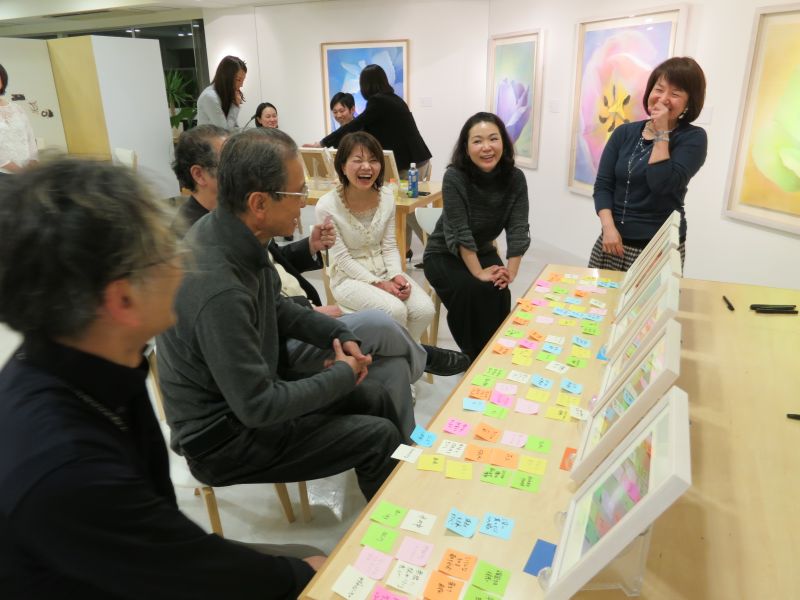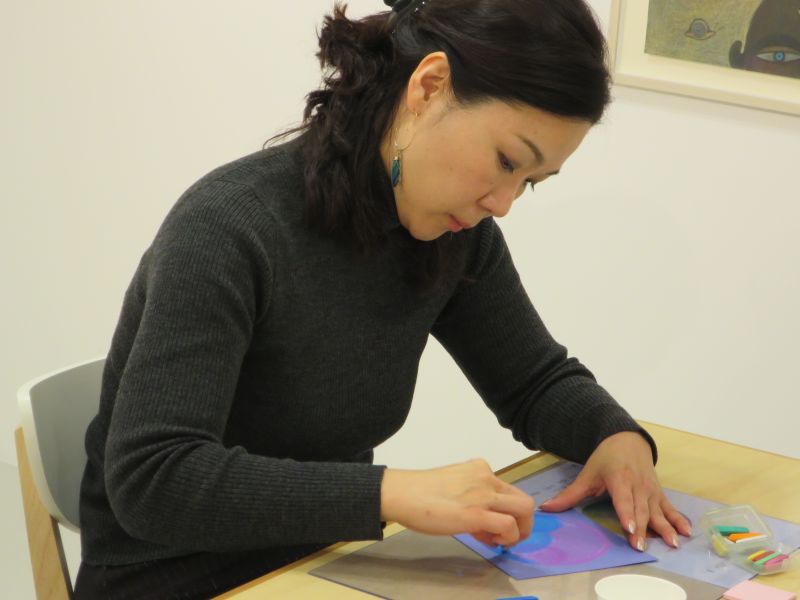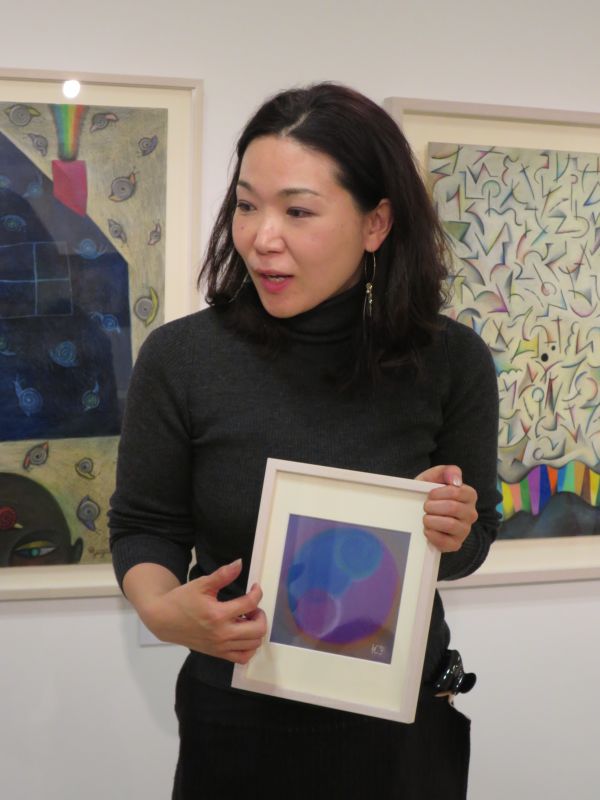Blown away by other participants’ works every time
 I remember the first time I did EGAKU in 2008 there was one participant at that session whose picture I honestly didn’t care for. But this same person mentioned that they liked my picture, and that stunned me.
I remember the first time I did EGAKU in 2008 there was one participant at that session whose picture I honestly didn’t care for. But this same person mentioned that they liked my picture, and that stunned me.
Throughout the TOTSUKITOKA program I’ve been inspired by so many people’s artworks. Seeing them makes think, “I’d like to paint like that,” or “I’d like to try using color in that way.” Very few people who take part in EGAKU work in the creative field or work in a similar field to myself, most come from a science, business or HR background. But I’m always blown away by the pieces they come up with, the sheer diversity and richness of their works - the composition, shapes, use of color. It’s the kind of creativity which makes me think, “Wow, I guess that kind of works!” “I’d never have thought of that, but that’s great!”. As I’ve pursued my practice of EGAKU, perhaps this is what’s fascinated me the most.
As someone working in design you find that over time you develop your own distinctive style, which is a good thing. At work, most of the discussions I have about design typically go along the lines of “Yes, I totally see what you mean. You’re right.” but then I come to EGAKU and I encounter the unexpected, so that really throws me. But it’s not an unpleasant feeling, it’s actually interesting. Perhaps the biggest change I’ve noticed in myself is that I’ve become more open to these kinds of emotions. I’ve become more open and tolerant of different kinds of people.
Even if you know people have different perspectives, it’s hard to get your head around this idea because these differences are invisible but in EGAKU these differences become visible. There are lots of strong personalities in the world of design and respecting each other’s personalities is important to making things work smoothly. But in EGAKU it feels a bit different. In EGAKU we all paint a picture on the same theme but every person has their own, unique approach to painting. It’s these completely surprising and unexpected approaches that other people come up with which I find eye opening. Moreover, everyone engages with the experience with such a serious and sincere attitude and that’s something that resonates with me. There are no personal interests involved. People aren’t there to seek attention or gain approval, or go out of their way to be eccentric or anything. And yet every time I come across such creative approaches, and I find that deeply inspiring.
Having my feelings read by other people gave me a sense of happiness
 The other important thing for me about EGAKU was that it helped me see that I'm fine just the way I am. In EGAKU a group of strangers who don’t know anything about your background look at your picture. This experience of having the kind of people I’d never usually meet, looking at my picture and reading my thoughts and feelings gradually gave me a sense of happiness. Every session, at least half the comments I received would stir up feelings like, ”Yes!! That’s it!! Thank you for seeing that in my picture.” Even if I couldn’t find the right words or explain things fully, I’d feel I was enough. I think that was important for me, seeing that I didn’t have to explain myself or try to change myself in order to be understood.
The other important thing for me about EGAKU was that it helped me see that I'm fine just the way I am. In EGAKU a group of strangers who don’t know anything about your background look at your picture. This experience of having the kind of people I’d never usually meet, looking at my picture and reading my thoughts and feelings gradually gave me a sense of happiness. Every session, at least half the comments I received would stir up feelings like, ”Yes!! That’s it!! Thank you for seeing that in my picture.” Even if I couldn’t find the right words or explain things fully, I’d feel I was enough. I think that was important for me, seeing that I didn’t have to explain myself or try to change myself in order to be understood.
In my job I always have to make presentations to help people understand my ideas, perhaps that’s why there’s this gap when I find myself being understood without any explanation. Depending on the project I’ll also be thinking how I’ve got to come up with a proposal that stands out from other people’s ideas, as well as grappling with questions about my own identity. But in EGAKU I never feel like I’m straining myself. No one’s judging you. Perhaps that’s one of the wonderful things about it.
I think it’s because I’m revealing my true self I feel grateful for the responses these people, these strangers, have to my picture. When people say unexpected things about my work, it makes me feel curious about their observations. It doesn’t evoke any negative emotions. I can hear them with an open and sincere mind.
We all have different perspectives, and that’s the beauty of it
 Perhaps some creative professionals might hesitate about taking part in EGAKU thinking, “Because I work in design, people might expect me to paint something special and extraordinary, something other people wouldn’t come up with.” However, once you experience EGAKU you realize there’s really no need to worry about this kind of thing. When you take part in EGAKU there’s absolutely no need to have any pretensions of being a designer. EGAKU is about encountering the excitement and originality of works created by people outside the creative industry, I think we need to experience that sense of wonder. It’s important to have this kind of experience from time to time. Some people might find it unsettling or unpleasant, but I think it’s outweighed by the feelings and awareness you get out of it.
Perhaps some creative professionals might hesitate about taking part in EGAKU thinking, “Because I work in design, people might expect me to paint something special and extraordinary, something other people wouldn’t come up with.” However, once you experience EGAKU you realize there’s really no need to worry about this kind of thing. When you take part in EGAKU there’s absolutely no need to have any pretensions of being a designer. EGAKU is about encountering the excitement and originality of works created by people outside the creative industry, I think we need to experience that sense of wonder. It’s important to have this kind of experience from time to time. Some people might find it unsettling or unpleasant, but I think it’s outweighed by the feelings and awareness you get out of it.
It’s the same thing when we’re looking at Kuni-san’s work. Occasionally I’ll hear a comment that makes me think, “Are you serious - is that what you see!?” but then again we all have different perspectives and that’s the beauty of it. I keep thinking how wonderful it would be to have kids in elementary school and kindergarten do this.
In the past I knew that people have different ways of thinking, but I don't think I’d accepted this at a deeper emotional level. I think TOTSUKITOKA was a process of slowly adapting my thinking and coming to terms with my emotions and experiences about tolerating and sharing difference.
The thrill of working with constraints
I’m actually not a big fan of pastels as a medium. I much prefer using color pencils to pastels. I’ve experimented with all kinds of approaches using pastels, for example changing the way I blended the colors, using the fixative spray multiple times. I’d constantly be doing things like checking out other people’s pictures and trying to figure out their technique, mixing different colors to get the color I was after, finding it wasn't working and trying again.
I had this constant feeling of having something I wanted to paint, but not being able to paint it. “I can’t paint the way I want to paint with the pastels, and the paper’s so rough I can’t get the colors to blend properly either!” These were the thoughts that went through my mind every time.
What frustrated me was the gap between what I wanted to paint and what I ended up painting. Giving shape to the image you see in your mind’s eye is a challenge even for artists, so I guess it’s only natural there’s going to be this gap for beginners. Even though I could have simply gotten fed up and decided to give up, I found I couldn't give up until I’d managed to somehow put the images in my head on paper. I think you simply have to have that kind of grit as a professional working in the creative field - seeing something through to the end and never giving up.
 At the beginning people working in the creative industry might feel that the various rules in EGAKU are constraints, getting in the way of diverse expressions. But I’d love them to experience the thrill of putting themselves in a completely new and unfamiliar situation and seeing something different unfold. I think there’s something interesting about putting yourself in an unfamiliar environment with unfamiliar people and then exploring the possibilities in that space.
At the beginning people working in the creative industry might feel that the various rules in EGAKU are constraints, getting in the way of diverse expressions. But I’d love them to experience the thrill of putting themselves in a completely new and unfamiliar situation and seeing something different unfold. I think there’s something interesting about putting yourself in an unfamiliar environment with unfamiliar people and then exploring the possibilities in that space.
Your background doesn't matter in EGAKU. I think it would be wonderful if everyone – including people working in the creative industries like myself – took up painting. At the end of the day you can't really judge a picture and I truly believe that if people just went right ahead and expressed their true selves it would do wonders for the spirit and body.
*This article is a translation of the original Japanese interview.